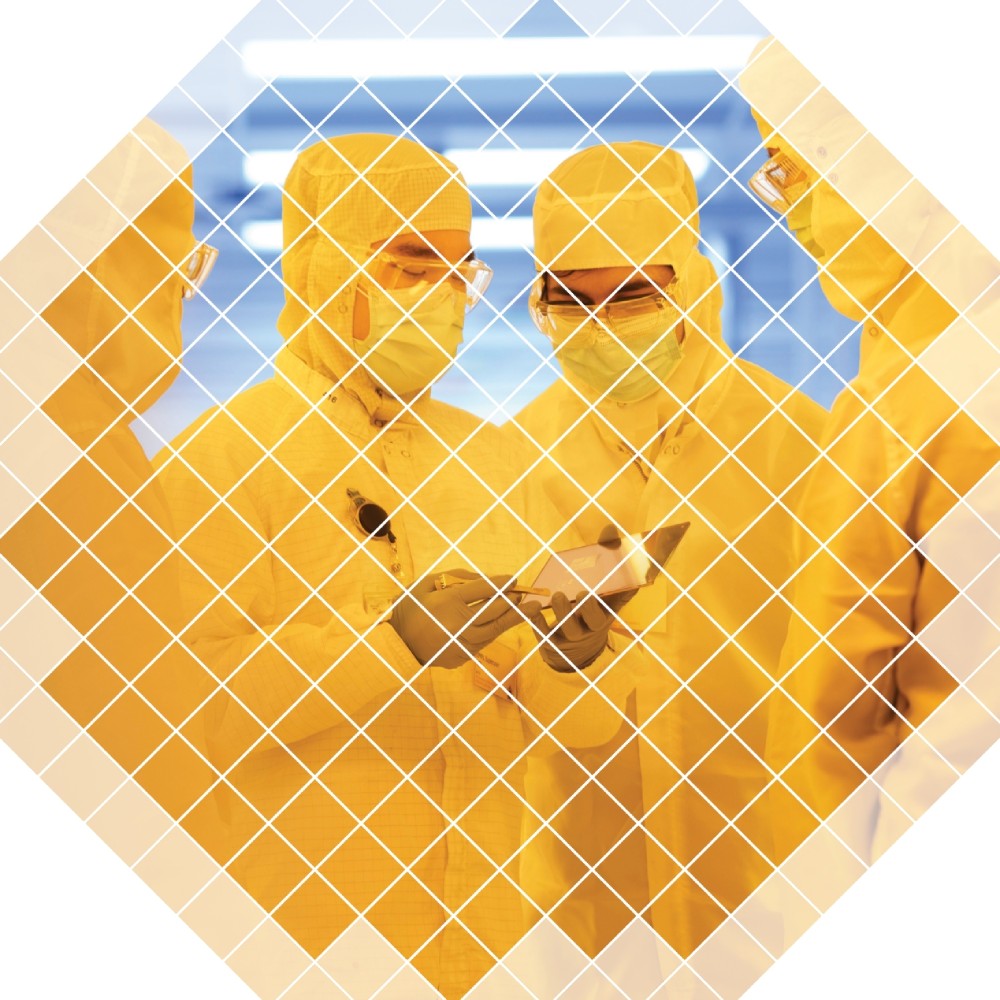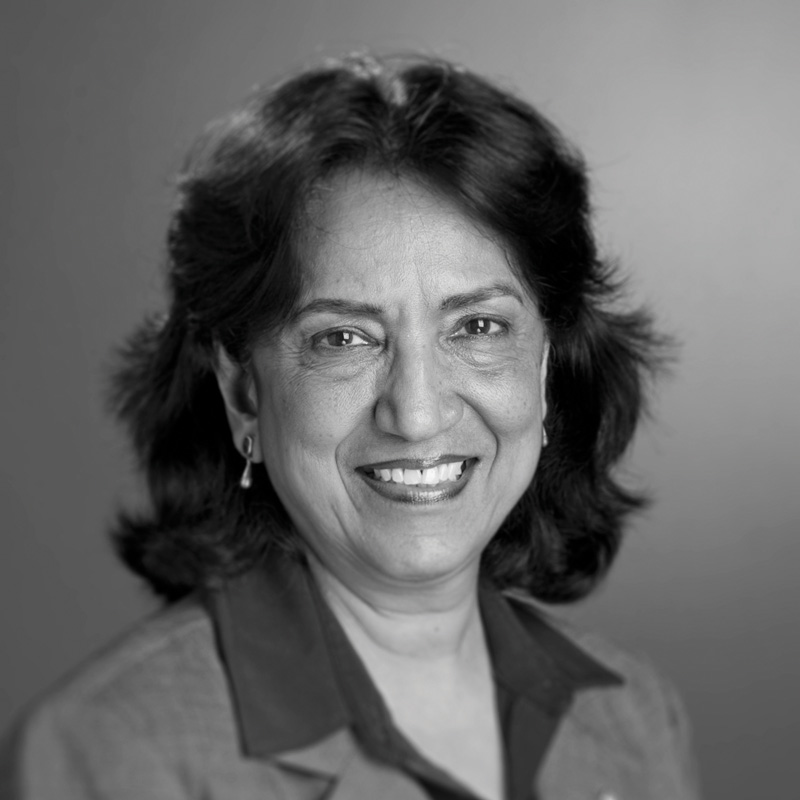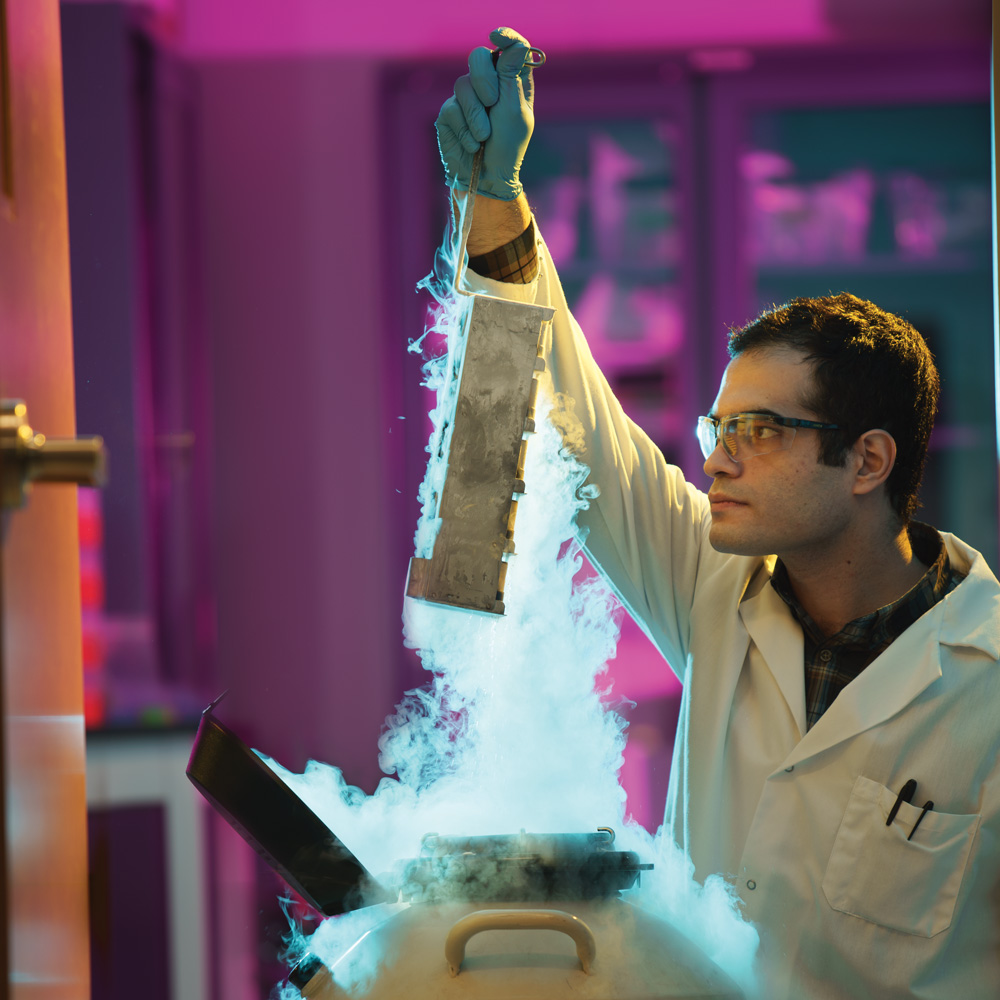Powering the Future
Powering the Future
Powering
the
future
RIT educates engineers to help solve global chip shortage
Microelectronic engineering students buzz around the RIT cleanroom applying specialized chemicals on semiconductor wafers. It is the first of many precisely controlled steps needed to convert the wafer into computer chips, tech used in today’s electronic devices.
For Adheesh Ankolekar, a first-year student in the program, it is the first phase of a career that is coming to fruition at RIT.
“I don’t really know anything—yet—but there is nowhere else I’d rather be right now,” he said.
Shayan Gholizadeh, well into his microsystems engineering doctoral program, uses the same technology to develop nanomembranes for tissue engineering and drug testing.
Both Ankolekar and Gholizadeh represent points on a pathway transforming students into process engineers and nanotechnology researchers who are in high demand in the semiconductor industry.
Computer chips, sometimes referred to as semiconductor devices, microelectronics, or integrated circuits, are elemental blocks in today’s electronics. They are used to power nearly every digital electronic device, appliances, and automobiles.
Supply chain disruptions and a strong demand for consumer electronics during the pandemic led to a global chip shortage. The shortage has highlighted the need to strengthen the domestic semiconductor industry and has put a new emphasis on microelectronic engineering education.
But this is not new at RIT.
The university’s connection to the semiconductor industry was established 40 years ago when it launched the first microelectronic engineering degree program in the country. Since then, RIT has graduated more than 1,500 engineers trained to make semiconductor devices.
Even more of those engineers integrate this important technology into next generation devices—from energy efficient products to biomedical sensors—that are enabling artificial intelligence, quantum computing, and advanced biomedical therapies.
“One of the key trends in the semiconductor industry is growth, and a growing concern that current manufacturing facilities cannot keep up with demand,” said Doreen Edwards, dean of RIT’s Kate Gleason College of Engineering. “We’ve all heard about the chip shortage and the desire to bring more semiconductor manufacturing back to the U.S. When this happens, there is going to be a growing need for qualified employees. This is where RIT and the Kate Gleason College can help.”
The first year
The path starts in the first-year microelectronic engineering courses where students learn how to build semiconductors—the brains inside today’s electronics.
They step into a cleanroom environment where semiconductor wafers, some the size of dinner plates, are produced through a complex process of patterning. Each wafer holds multiple small but extremely powerful computer chips that have intricate collections of transistors, wiring, and high-tech sensors.
“You learn the right way to build the semiconductor devices,” said Ankolekar, who came to RIT from Pittsford, N.Y., where he was a 3M Young Scientist Challenge state merit winner. “Computer chips are everywhere, and this class is a good way to see the different applications and how companies are using computer chips.”
Faculty ensure that microelectronic lab work is hands-on from the first day. It is also common for first-year students to interact with doctoral candidates like William Huang, a teaching assistant (TA), who led Ankolekar and his classmates in a semiconductor processing lab.

“My role as a TA is to explain how microchips are made and why certain processes are done in a certain way while providing hands-on opportunities for the students to incorporate theoretical and practical knowledge,” said Huang ’19 (microelectronic engineering), ’19 MS (materials science and engineering). He also helps train other researchers to be certified to use cleanroom equipment.
As an undergraduate, Huang held internships at Element Six Technologies and Adzara BioSystems before returning to RIT to pursue a Ph.D. in microsystems engineering.
Sean Rommel, professor and microelectronic engineering program director, said companies reach out to RIT for both internships and full-time positions.
Some of those jobs are with companies producing consumer electronics; others are in the defense, automotive, and energy sectors.
Graduates are finding positions with companies that manufacture solar panels and devices for smart cities. Others are making an impact in health care building preventive devices.
“They know about our program, its depth and the hands-on nature of the coursework,” Rommel said. “Companies see this experience as an asset. At some of these companies, you are in a cleanroom like ours. I hear from students that their work resembles this experience.”

National Impact
Santosh Kurinec, a professor of microelectronic engineering, will represent RIT on the American Semiconductor Academy, a national initiative that will help solve the computer chip shortage.
Consisting of academic, corporate, and government agency representatives from across the country, the academy is tasked with improving manufacturing processes and increasing a skilled workforce. According to the Semiconductor Industry Association, U.S. semiconductor companies have 47 percent of the global chips sales market, but only 12 percent are manufactured in the U.S.
“The time has come that we should tell our young people that they can build integrated circuits, that we cannot rely on all imports anymore,” said Kurinec, an expert in CMOS technology (a fabrication design process) and photovoltaics. “We have to do our own research, development, and manufacturing.”
Semiconductors in health care
Gholizadeh is part the newest area of microelectronic engineering education at RIT—tissue engineering. He is working with associate professor of biomedical engineering Thomas Gaborski, a leading researcher of nanomembranes.
By testing and refining prototype platforms called nanomembranes, they are helping scientists gain an in-depth understanding of how and why a disease, such as Alzheimer’s, starts well before its onset.
“You can provide a treatment strategy that allows for a much better prognosis of this disease, a better quality of life, and higher life expectancy,” he said.
Typically made up of organic or inorganic materials, nanomembranes can be silicon dioxide—essentially glass at nanoscale—and silicon nitride. Gholizadeh works on organic polymeric membranes, substances that are biocompatible and approved for coating implants. Gaborski’s team uses lithography and other microfabrication techniques to make the nanomembranes.
Conventional porous membranes are commercially available yet have low porosity and low yield. They are not optically transparent, so imaging through them is essentially not possible or very hard to achieve, said Gholizadeh.
“Our membranes are 10 times thinner than conventional membranes, a closer representation of the human body,” he said.

Doctoral student Shayan Gholizadeh looks at a frozen cell inventory kept in liquid nitrogen in one of the biomedical engineering laboratories.
RIT’s Semiconductor Microsystems and Fabrication Laboratory is being renamed RIT NanoLabs to reflect how the university is expanding into this area of biomedical research as well as integrated photonics, smart manufacturing, quantum computing, and other advances to the Internet of Things.
RIT is also updating and expanding its cleanroom. Changes will include upgrades to filtration and air handling systems, the addition of new wet processing stations to prevent cross contamination, and the creation of 5,000 square feet of research space focused on biomedical applications.
The updates and new focus excite students such as Ankolekar. It’s too early in his education for him to say what area of microelectronic engineering he’ll focus on, but he likes having options.
“The program is a good fit for me because our college takes an exploratory approach to making computer chips,” he said. “I’ll be able to apply this to something I am passionate about.”
What do you do with a MicroE Degree?
Here are five notable alumni working in a range of fields.
Sensor technology
David Borkholder ’92 (microelectronic engineering) developed BlackBox Biometrics, which helped measure blasts causing brain trauma in soldiers in wartime. Borkholder and his team also developed Linx IAS, a similar technology used to help parents, coaches, and players understand concussion-causing impacts. Currently, Borkholder is the chief technology officer at Casana and co-developer of The Heart Seat, a monitoring device designed to collect patient data unobtrusively about heart rate, blood pressure, oxygen levels, and cardiac information. He is also the Bausch and Lomb Professor of Microsystems Engineering at RIT.
Computer chips
As deputy director of research and development at Global Foundries, Keith Tabakman ’03 (microelectronic engineering) oversees computer chip and wafer operations process improvements. Global Foundries, the fourth largest semiconductor manufacturer in the world, produces computer chips for the global marketplace. Tabakman helped develop advanced CMOS technology (a fabrication design process) to meet the increased demand for manufacturing more computer chips needed in multiple industries.

Space
When the robotic helicopter Ingenuity took flight during NASA’s Perseverance Rover mission in July 2020, it proved controlled flight was possible in the mysterious atmosphere of Mars. Chelsea Mackos ’09 (microelectronic engineering), ’11 MS (materials science and engineering), was part of the SolAero Technologies team that helped build solar panels for the helicopter that has since performed more than 20 fact-finding missions. As director of operations for SolAero, Mackos uses her process engineering experience to coordinate the development and production of solar equipment in the company’s photovoltaic lab. Mackos has been at SolAero in New Mexico since 2012.
Patent specialist
Leonard Chang ’07 (microelectronic engineering) helps inventors patent new technologies and ideas. The intellectual property/patent specialist with the U.S. Patent and Trademark Office in Washington, D.C., uses his microelectronic engineering background to assess the potential viability of others’ tech devices.
Cloud engineer
Rishmithaa Sivakanthan ’20 (microelectronic engineering) made an impression as an intern at Micron where she used skills acquired from the RIT semiconductor fabrication lab to help improve yield and efficiency among different process areas at the company. She was hired by the company in 2020 as a cloud engineer with DRAM (Dynamic Random-Access Memory) Engineering Group.









